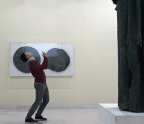Between Light and Nowhere

“Every man takes the limits of his own field of vision for the limits of the world. This is an error of the intellect as inevitable as that error of the eye which lets us fancy that on the horizon heaven and earth meet.”
—Arthur Schopenhauer, Studies in Pessimism
“You can’t choose between life and death when we’re dealing with what is in between.”
—Tangina Barrons (Zelda Rubinstein), Poltergeist (1982)
riting in in 2014, cultural critic Ara Osterweil proposed that American artist James Turrell’s careerlong Light and Space project is not only kindred with experimental film, but could rescue the cinema from mounting fears of its impending extinction and bury the theoretical obsessions with medium specificity that have obscured its redemptive potential. Divorced from market-dictated determinations, his work extricates us from a social world that Jonathan Crary describes as “non-stop,” conformed to the mechanical modes of production demanded by 21st-century capitalism. In such a domain, “distinctions between day and night, between light and dark, between action and repose” can no longer be undermined. Once again, we truly . Turrell, though, doesn’t use a camera or any other cinema apparatus to produce or present his work; rather, he needs nothing more than natural and artificial luminance and the architecture (1980-86)—a room with a geometric opening in its ceiling to frame the exposed sky for viewers’ contemplation, characteristic of his signature Skyspace works—Osterweil details how the piece not only offers a meditational, cosmic experience but also the ability to “re-frame the ordinary world, [thus restoring] it to perceptibility,” an effect she compares to that offered by the Lumières’ early . The sky is the image the object in , and so fulfills cinema’s expanded perceptual potential without abandoning Bazin’s core fantasies for the medium.
You’re reading a preview, subscribe to read more.
Start your free 30 days





